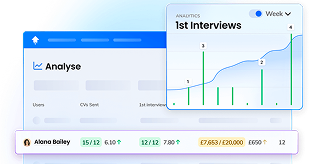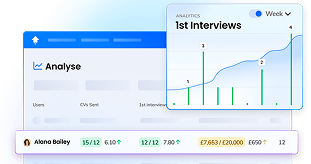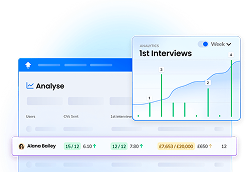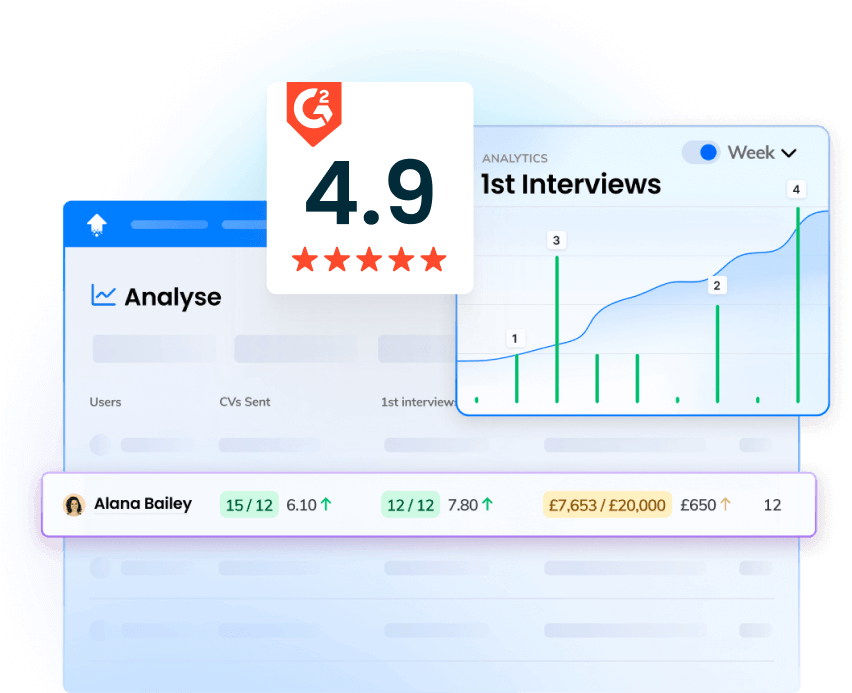The recruitment industry is more competitive than ever, and agency leaders must ensure their teams are operating at peak performance. With recruiters bringing varying skills and experience levels, a performance-based recruitment strategy is essential to drive continuous improvement.
At the core of this strategy is tracking performance. A well-structured recruitment report template provides a clear overview of the recruitment process, offering real-time insights into key metrics such as time to hire, candidate quality, and source effectiveness. By analysing recruitment data, hiring managers can refine their hiring strategies, optimise resource allocation, and identify areas for improvement.
Comprehensive recruitment reports help agencies spot trends, enhance hiring decisions, and streamline the recruiting process. With structured reporting, recruitment leaders can ensure a strong recruitment funnel, improve candidate experience, and drive overall success.
In this article, we’ll explore the best recruitment report templates and how to leverage data to optimise recruitment efforts in 2025.
Why Recruitment Reports Are Critical for Team Managers
Regular reporting in recruitment is crucial for maintaining a competitive edge and ensuring effective hiring practices.
So, what is a recruitment report?
It’s a structured way to measure key recruitment metrics like time to hire, candidate conversion rates, and source effectiveness. It helps hiring managers see how well their recruiting teams are performing and where they need to improve.
But recruitment reports do more than just track performance. They provide valuable insights that help agencies spot trends, refine hiring strategies, and improve overall efficiency. With the right reports, team leads can identify bottlenecks, adjust recruitment efforts, and ensure their teams are working at peak performance.
To make the most of recruitment reports, agencies need the right tools. Different reports serve different purposes, from tracking individual consultant performance to evaluating the entire recruitment pipeline. So, what types of reports should you create, and how should they be structured?
11 Recruitment Report Templates for Team Managers
So, now we know how important recruitment reports are for hiring success, what types of reports should you create, and what should they look like?
Read on to find out about 11 useful recruitment reports with handy examples.
#1 - Weekly Performance Reports
Your weekly performance report is used to track individual and team performance on a weekly basis.
It should look something like this recruiting report example.

The specific metrics you use will depend on what type of recruitment agency you are and whether you're paying particular attention to specific areas of performance.
For example, if your cost per hire is creeping up, you may want to add this to your recruitment weekly report format to keep a closer eye on it.
However, it's always a good idea to include the following key metrics:
- Jobs added
- CVs sent
- Interviews
- Placements
- Revenue booked
List your individual recruiters down the side of the weekly recruiting report so you can clearly see their performance for each key metric, and include a 'total' column that displays overall agency performance that week.
On a separate tab, repeat this exercise, but list teams instead of names.
So, how can you use this weekly recruitment report most effectively?
Bring this recruitment summary report out at your Monday morning meetings or Friday wrap-ups to identify which recruiters are hitting their targets and who needs to work more on increasing specific metrics.
This should foster a sense of accountability among recruiters and drive healthy competition — after all, no consultant will want to generate the lowest number of placements made week after week.
It also shows recruiters where they need to spend their time and helps agency leaders identify bottlenecks.
For example, if your report displays plenty of jobs added but barely any CVs sent, you need to find out why there's a hold-up and take swift action to resolve it.
Pro Tip: Display targets alongside performance metrics to see who needs extra guidance.
#2 - Individual Consultant Progress Reports
An individual consultant progress report is used to track one recruiter's performance over a defined period.
For instance, you may set up these reports to measure progress week-on-week, month-on-month, or even quarter-to-quarter.
This is how an individual consultant progress report should look.

In terms of metrics, you need to track some general OKRs that determine general recruiter performance, as well as some that track areas that the recruiter has been struggling with.
Typical metrics on an individual consultant progress report include:
- Jobs added
- CVs sent
- First interviews
- Second interviews
- Offers
- Placements
These reports are most valuable for one-on-one meetings and tracking personal development over time.
For best results, take a tailored approach to individual consultant progress reports.
For example, you might use these reports to closely monitor new starters' progress.
This report can then be used to complement probation meetings and allow managers to have meaningful conversations.
It also helps new starters to understand how they're progressing against their targets.
For more experienced consultants, you can bring these reports into one-to-ones, use them to highlight areas that need improvement and monitor their learning and development.
They can also be used to inform promotions and pay rises and motivate recruiters to work towards defined goals to achieve these rewards.
#3 - Team Comparison Reports
As an agency leader with multiple teams or offices, it's beneficial to know how your teams rank in terms of performance.
You need to have oversight of which teams are excelling and which are floundering — and why.
This is where team comparison reports come in.
Here's an example of a straightforward team comparison report comparing contract, delivery, and perm team results.

Below is a slightly different approach.
This report compares the performance of teams in two different offices.

Team comparison reports typically focus on revenue targets over different time periods.
In the examples above, the teams' total overall revenue booked figure is displayed alongside the total revenue booked for the month and quarter.
The figure is shown alongside the target, with handy traffic light colour coding making it immediately apparent which teams are on track to hit their revenue goals, and which are not.
Revenue is also broken down by temporary and permanent contracts, and a summary bar shows the running total in each category.
Remember — you don't have to stick to predefined teams — with OneUp, you can add people to multiple teams.
So if, for example, one of your teams is performing especially poorly, you can split that team up into different groups for tracking purposes to get to the bottom of the issue.
#4 - Conversion Reports
Conversion reports give you a handy overview of the quality of your consultants' work.
You can create conversion reports for individual consultants, as seen in the recruitment report example below.

Or change your recruitment report format and create conversion reports to monitor team performance.

Within your conversion reports, you may wish to track the conversions between:
- CVs sent : First interviews
- First interviews : Second interviews
- CVs Sent : Placements
This will show you, for example, how many CVs sent result in first interviews, how many CVs sent lead to placements, and how many first interviews move on to second interviews.
By closely examining conversion rates at different points in the hiring funnel, the quality of your recruiters' work is revealed.
For instance, if a very low number of CVs sent lead to first interviews, there may be an issue with that recruiter's sourcing strategy.
Perhaps they're sourcing from the wrong job boards, for example.
In this way, you can use conversion reports to determine where recruiters are excelling and where additional training is required.
#5 - Business Development (BD) Reports
Business development reports are an invaluable tool in markets where proactive business development is vital to agency success.
And with the recruitment market becoming ever more competitive, BD activities have increasingly become a part of recruitment consultant roles.
Here's a business development recruitment report sample.

As you can see, these reports are designed to monitor the frequency of BD activities and metrics such as:
- BD emails
- BD calls
- Jobs added
A running total of business development activity gives you a helpful overview of how much time individual recruiters and teams are dedicating to BD-related work.
You can also look at these figures from an overall agency perspective to get a grasp on the bigger picture.
These reports highlight gaps in BD activity that need to be improved, empowering managers to take swift action to increase jobs added.
For deeper insights, throw some conversion metrics in there, too, such as:
- BD calls : Client meetings
- BD activity : Jobs added
#6 - Performance Funnel Reports
A performance funnel report is a simple but incredibly useful tool that visualises the entire hiring process from outreach to placement.
Include conversion metrics alongside quantity metrics for a clearer view of recruitment funnel performance.
Take a look at this recruitment analysis report template.

Within your performance funnel report, include the following metrics and conversion metrics:
- CVs sent
- CVs sent : First interviews
- First interviews
- First interviews : Offers
- Offers
- Offers : Total placements
- Total placements
- Total revenue booked
Use performance funnel reports to identify issues or bottlenecks in your recruitment funnel, before digging into your quantitative and qualitative data to discover the root cause.
Then, take swift action to resolve these issues before they begin to impact the agency's reputation.
#7 - Year-in-Review Reports
Track your agency's performance throughout the year with your year-in-review report.
These reports make it super easy to compare how the business is performing when it comes to those all-important revenue figures.
It's also useful for seeing year-over-year trends and tracking overall revenue.
Here's an annual recruitment report template.

Simply set up a report comparing your annual performance with previous years.
It's worth digging deeper and adding quarter-on-quarter and month-on-month comparisons to the report, too.
And don't forget to include your targets!
#8 - Multi-Year Quarterly Comparison Reports
Compare quarterly performance against previous years to spot trends in activities, revenue, or placements.
These reports can give you deeper insight than simply comparing year-over-year, as they reflect seasonal fluctuations and trends.
Here's an example of a multi-year quarterly comparison report.

Choose any recruitment metric you wish to track annually, and set up reporting broken down by the four quarters.
Then set up the report to display historic performance, again broken down by quarter.
Multi-year quarterly comparison reports are helpful in evaluating long-term team performance and setting benchmarks for growth.
#9 - Timesheet Reports for Contract Roles
This is one for agencies or teams working with contract or temp roles.
Timesheet reports for contract roles track approved timesheets over a specific period.

Simply list your contract or temp recruiters, and set up a category for approved timesheets and timesheet margin approved.
Pro Tip: Integrate with your timesheet system for seamless tracking.
#10 - Min/Max/Average Reports
Create a report to monitor minimum, maximum, and average performance stats.
Choose a metric you wish to measure, such as monthly billings or placements, and then change the 'metric value' setting on your OneUp report to 'minimum,' 'maximum,' or 'average,' as below.

Why is this useful?
Use the minimum setting to see what your top performers' minimum stats look like.
You can then use this as a benchmark for other consultants.
Maximum stats can be used to identify what is possible and use this to inform your targets.
For example, you could identify which month last year came top for billings and consider this figure when forecasting.
Of course, working out averages is super useful, too, whether you're forecasting or examining recruiter performance.
#11 - Last Activity Reports
As any team leader knows, some recruiters need more encouragement than others to put in the work required to hit their targets.
Last activity reports tell you the hard facts about your consultants' activity levels.
Here's a recruitment activity report template to take inspiration from.

To set up your last activity report, first identify the activities you want to track.
For example, this could be the last time a consultant:
- Sent a CV
- Added a job
- Made a BD call
- Scheduled an interview
- Placed a candidate
Your last activity report will tell you exactly how many days it's been since each consultant performed one of the activities above.
This report makes it easy to identify inactive consultants, and makes for more productive discussions around performance in one-on-ones.
Then, you can intervene when someone is dropping the ball and praise hard work, too.
Tracking Success with OneUp's Mission & League Reports

Recruitment reporting software OneUp allows you to track the success of your recruiters — and give them a motivational boost — via its missions and leagues feature.
To create a mission or league, decide which metric or behaviour you want to see more of.
Then, create a target for this metric and attach an appealing incentive.
OneUp will pull real-time data from across your tech stack to report on your consultants' progress.
What's more, you can display live leaderboards around your office to enhance motivation, with rankings updated in real time.
When a recruiter hits their target, an automated personalised celebration anthem or broadcast message will play across your screens.
And if you're worried about missing any crucial updates, simply automate reports to land in your inbox whenever you need them.
Keen to see what kind of effect these motivational tactics can have?
Why not track the results from a week with a business development-focused league and compare it to a week without leagues?
You can also compare performance before and after running an incentive to see what drives the best results.
Best Practices for Using Recruitment Reports Effectively
A well-structured recruitment report template is essential for optimising your recruitment strategy and ensuring the hiring process is as efficient as possible. However, simply creating a recruitment report isn’t enough - its effectiveness depends on how well it aligns with key metrics, supports hiring managers, and improves the entire hiring process.
To maximise the impact of your recruitment efforts, follow these best practices for performance-based recruitment reporting:
- Set clear goals and realistic targets to track progress throughout the recruitment process and ensure accountability across the recruiting team.
- Regularly review key metrics such as time to hire, conversion rates, and acceptance rates to assess hiring success and optimise recruitment activities.
- Customise reports to focus on specific job descriptions, job openings, or recruitment campaigns, ensuring they serve the needs of senior leadership, key stakeholders, and potential clients.
- Use a recruitment dashboard for a visually appealing, real-time overview of the recruitment funnel, helping to spot trends and identify bottlenecks in the hiring process.
- Leverage data-driven decisions by integrating recruitment analytics to improve resource allocation, applicant pool insights, and overall recruitment strategy.
- Automate reporting with OneUp to save time, streamline weekly recruiting reports, and reduce manual tracking of recruitment efforts.
- Share reports with your recruiting team and other stakeholders to promote transparency and accountability, helping to improve candidate experience and employer branding.
- Continuously update and refine reports to reflect changes in the hiring strategies, source effectiveness, and pipeline report metrics, ensuring reports remain relevant and drive continuous improvement.
A well-executed recruiting report doesn’t just measure how many candidates were hired - it provides valuable insights into quality candidates, employee retention rate, and diversity metrics. By following these best practices, hiring managers can ensure their recruitment efforts are data-driven, efficient, and aligned with business goals for overall success.
Conclusion: Why Recruitment Report Templates Are Key to Success
Using customised recruitment report templates is essential for tracking and improving team performance.
These tailored reports focus on the most relevant metrics, such as placement rates, time to hire, and consultant efficiency, offering clear insights into team strengths and areas for development.
Recruitment agencies can use these reports to make data-driven decisions, optimising strategies, and resource allocation to improve performance.
Furthermore, by tracking key trends, agencies can identify bottlenecks and successes, enabling them to coach consultants more effectively and streamline operations.
Leverage OneUp's tools, which offer real-time data, customisable dashboards, and automated reporting features, for reporting success.
These tools simplify performance management, allowing for a more targeted approach to improving consultant outcomes and overall recruitment efficiency.
Ready to unlock your recruiters' full potential? Book a demo with OneUp today and discover how our powerful reporting tools can help you streamline performance tracking, make data-driven decisions, and boost consultant success.




















